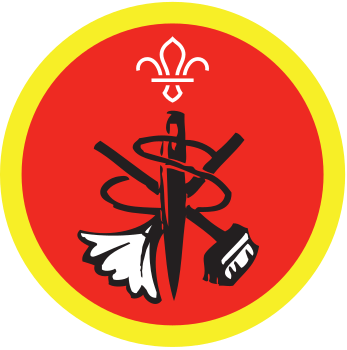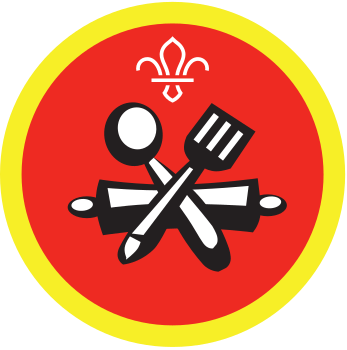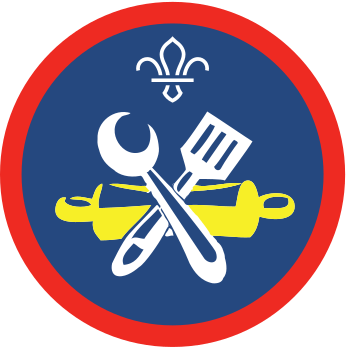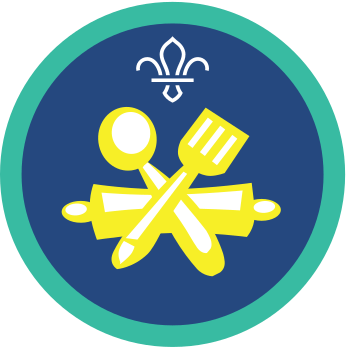
Cook Fårikål
You’ll need
- Chopping boards
- Pans
- Hob
- Wooden spoons
- Spoons
- Vegetable peelings (or other green food waste)
- Plates
- Forks
- Knives
- Access to water
- Sharp knives
- 2 large saucepans with lids
- Tea spoons
- Jug
- Kettle (optional)
- Heatproof protective equipment, such as oven gloves
Før du begynner (Before you begin)
- Use the safety checklist to help you plan and risk assess your activity. Additional help to carry out your risk assessment, including examples can be found here. Don’t forget to make sure all young people and adults involved in the activity know how to take part safely.
- Make sure you’ll have enough adult helpers. You may need some parents and carers to help if you’re short on helpers.
Roverway is a European event for Scouts and Guides aged 16 to 22, which takes place every three to six years. It is a unique event due to its age range and emphasis on youth-led adventure.
The next Roverway will take place in Norway in summer 2024. The event is divided into three parts: a semi-independent expedition, a jamboree-style camp and a post-event experience. Find out more on our Roverway 2024 page.
Norway is a Scandinavian country in Northern Europe that has mountains, glaciers and big bodies of water, which are called fjords. Many Norwegians embrace the nature through outdoor activities such as kayaking, hiking and skiing. Oslo is the capital of Norway.
Fårikål is a traditional Norwegian dish that is usually eaten during the autumn months. It is a simple dish that consists of lamb and cabbage cooked together in a pot with a few basic spices. Despite its simplicity, fårikål is considered one of Norway’s national dishes and is enjoyed by many people across the country.
Fårikål is translated to “lamb in cabbage” and is very similar in appearance to a stew.
It is suggested that the lamb stew recipe is most likely inspired by a similar Danish dish with duck, which was introduced in Norway as early as the 19th century. But with over a million sheep, that’s one for every sixth person, its no wonder it was adapted to a lamb recipe.
- Remember to check for allergies, eating problems or dietary requirements and adjust the recipe as needed. Make sure you've checked everyone's dietary requirements and allergies then adapted the recipe as appropriate. This may include ensuring no cross-contamination during food preparation, too.
- Check if there are any items of food (or packaging) that people can’t touch or be near to or if there are items that people might not be comfortable using in the activity.
- Some people may not like certain food textures or tastes and that’s OK. Try to find an alternative for them. No-one has to use all the ingredients or be made to try foods if they're not happy, comfortable or don’t want to.
- Remember to have a hand washing station and take extra hygiene precautions when handling food.
- Take a look at our guidance on food preparation.
- Make sure you have all the ingredients ready.
- You may want to run a kitchen safety talk and show people how to use the equipment safely, such as for cooking or chopping ingredients. You could run our kitchen safety and hygiene activities, Kitchen risk bingo and Home kitchen hygiene prior to running this session.
- If you’re using a gas stove, make sure it’s on a stable heatproof surface and in a clear and open area, with plenty of ventilation. Gas can increase risk of carbon monoxide exposure.
- Depending on your meeting place, you may wish for groups to make or prepare the ingredients in a wider, more spacious area, then invite each group into the kitchen to cook one at a time. Remember the groups not using the kitchen or cooking will still need to be supervised, always following the Yellow Card.
Gjør klar denne aktiviteten (Setting up this activity)
-
The stew in this activity takes 1.5-2 hours to cook. You may wish to pre-make the stew or pre-chop the ingredients. You may also wish to run this activity on a residential or Nights Away event as dinner.
Ingredients
- 3kg of lamb chunks
- 3kg cabbage
- 8 teaspoons of whole, black peppercorns
- 4 teaspoons salt
- 600ml water
- 2kg of potatoes
- Flat breads (optional)
- Lingonberry jam (optional)
Prep time: 15 minutes
Cook time: 1.5-2 hours
Makes: 8 servings
Lag maten! (Make the food!)
- Gather everyone together in a circle. Explain that you’re going to make Fårikål. Explain that lamb and cabbage stew, or ‘fårikål’ in Norwegian, has repeatedly been named Norway’s national dish. It even has its own festive day on the last Thursday in September. Throughout the autumn months, people all around the country arrange lamb stew parties.
- Everyone should wash their hands, then ask everyone to get into groups. They should gather the equipment and ingredients they need. An adult should always be assigned to and supervising each group during this activity.
- Someone should clean and wash the cabbage and potatoes.
- When ready, carefully slice the cabbage into wedges, about 2-4 cm thick.
- Next, someone should cut the lamb meat into smaller pieces, approximately 1.5cm wide. They should be bite-sized chunks. Make sure to place any equipment used to cut meat safely and clearly to one side, ready for washing up. It’s important to never leave knives in a washing up bowl, as this means they might not be seen by someone doing the washing up. Your group may want to wash this equipment up straight away to prevent cross-contamination of raw and cooked meat
- Someone should peel the potatoes, then chop them into small chunks. This means they’ll take less time to boil.
- With adult supervision, layer the cabbage and meat in a large saucepan, adding salt and pepper between the layers. Your first layer should be meat. Some people like to add 2–4 teaspoons of flour evenly between the layers, as this helps to thicken the sauce.
- When it’s ready, an adult should add water. There should be enough water to make sure all the ingredients are just covered.
- Carefully add the lid to the pan, then bring it to a boil.
- Once it’s been brought to the boil, you can lower the temperature and let the stew simmer for about 1.5 to 2 hours.
- While the stew is cooking, add the potatoes to a separate pan. You should add water to the pan, with enough to submerge the potatoes, then add the lid and boil them for around 30 minutes. Once they’re cooked, an adult should carefully remove the pan from the heat source, using heatproof protective equipment, and turn the heat source off. They should be left to one side, on a heatproof surface and out of reach of young people. You can keep them as boiled potatoes or you may choose to use them to make mashed potatoes.
- When it’s ready, an adult should remove the lid with heatproof protective equipment. They should carefully check the meat is tender and easy to pull apart. You may want to use a food thermometer to make sure everything is cooked through.
- Once the stew is cooked, an adult should carefully remove the pan from the heat source, using heatproof protective equipment, and turn the heat source off. The stew should be left to one side, on a heatproof surface and out of reach of young people.
- Once it’s cooled, you can serve your Fårikål hot. You may wish to serve it with some flatbread or lingonberry jam.
Reflection
This activity gave everyone the opportunity to try something new and work as a team to cook some Fårikål. Have you made anything similar before? How easy was it to make? What was it like following the recipe.
You had to work as a team to make the stew. How did you make sure everyone could be involved? How did you make sure everyone could share and use their skills? Did everyone get to have a turn at the different stages, such as chopping? Did you have any problems? If so, how did you solve them? How did you make sure everyone stayed safe too?
Safety
All activities must be safely managed. You must complete a thorough risk assessment and take appropriate steps to reduce risk. Use the safety checklist to help you plan and risk assess your activity. Always get approval for the activity, and have suitable supervision and an InTouch process.
- Cooking
Teach young people how to use cooking equipment safely. Supervise them appropriately throughout. Make sure it’s safe to use and follow manufacturers’ guidelines for use.
- Food
Remember to check for allergies, eating problems, fasting or dietary requirements and adjust the recipe as needed. Make sure you’ve suitable areas for storing and preparing food and avoid cross contamination of different foods. Take a look at our guidance on food safety and hygiene.
- Hot items and hot water
Kettles, cookers and microwave ovens produce a lot of heat by the very nature of them. Caution is needed when in contact with items that have been heated and young people should use them under adult supervision. Use on a suitable surface, protecting it if necessary. Never leave hot items unattended and make sure there’s a nearby first aid kit, with items to treat burns/scalds.
- Fires and stoves
Make sure anyone using fires and stoves is doing so safely. Check that the equipment and area are suitable and have plenty of ventilation. Follow the gas safety guidance. Have a safe way to extinguish the fire in an emergency.
- To make this activity easier, you could pre-cut the ingredients before you begin.
- To make this exercise harder, try cooking them outside on open fires. Ensure you make sure anyone using fires and stoves is doing so safely. Check that the equipment and area are suitable and have plenty of ventilation. Follow the gas safety guidance. Have a safe way to extinguish the fire in an emergency.
- If anyone needs help or struggles with fine motor skills, give them the opportunity to work in pairs or small groups. They could also work with a young leader or an adult volunteer. The person they’re working with can help with the parts they find fiddly to do or tricky.
- If anyone struggles with fine motor skills, a funnel could be used to help them pour the ingredients into a bowl or jug.
- If you’re measuring out ingredients, anyone who struggles with maths can partner up with or join a group with someone who’s more confident at the measuring part of this activity. Alternatively, a young leader or adult could support them in the measuring part of this activity.
- Remember, some baking and cooking activities can be done either sitting or standing – people can choose whichever way is best for them. People could work with a partner, with one taking on any standing tasks and the other doing tasks seated.
- There are lots of loud noises and different smells in a kitchen or while cooking, which may overwhelm some people. People may choose to wear ear defenders while in the kitchen, take a break from the activity or prefer to stay a distance away from the activity and that’s OK. You could use fragrance free soap or washing up liquid or have items pre-chopped to reduce noise. You might also want to keep any blending, electric whisks or noisier equipment to being used in one room and shut the door, so people have an option to step out if it’s too loud. Check before and during the activity that everyone is comfortable, and make sure everyone knows that they can leave the activity at any point. It might be useful to agree a signal people can use, such as raising their hand, to stop take a break for the activity or if they need to speak to an adult.
All Scout activities should be inclusive and accessible.
If you enjoyed this activity, you could make some Norwegian Waffles.



